


Ghana: Highlights of Ghana
Day 1: Arrival at Accra - Aburi
Meet and greet with your tour leader and transfer to the hotel in Aburi
(30 km)
(-/-), overnight at Aburi, Aruba Guesthouse or similar
Day 2: Aburi - Akosombo
This morning we will visit the Botanical Garden of Aburi and become
acquainted with indigenous plants from Ghana and also many exotic
trees imported from Asia, South America and other parts of Africa.
Founded by Britain in 1890 this park is a Garden Eden for those who
look for a peaceful hang-out as well as for the botanically interested. At
Mampong we will walk through Ghana’s oldest cocoa farm founded by
Tetteh Quarshie in 1876. In 1876 he brought the first cocoa seedlings to
Ghana from the island of Fernando Po. Till now, some of the original
trees have been preserved. The drive through the mountains continues
to Odumase. There is a factory where glass beads are made from old
bottles recycled and processed into colourful fashion jewelleries that are
exported worldwide. In the afternoon you reach Akosombo. (approx. 110
km)
(B/D), overnight in Akosombo, Adi Lake Resort or similar
Day 3: Akosombo - Wli
Today we continue the journey heading north to the small town of Wli
boasting Ghana‘s largest waterfalls. En route we stop at Tafi Atome
where we may have a close encounter with the rare Mona monkeys. The
Tafi Atome Monkey Sanctuary was established in 1996 to protect the
animals from poachers and other enemies. For the population the
monkeys are sacred because it is believed they are messengers to the
gods. This afternoon a 45-minute-walk on a flat, easy footpath takes us
to the waterfall, where an impressive bat colony populates the steep
walls. Nine wooden bridges are constructed over the small river winding
through the giant jungle trees. (approx. 150 km)
(B/D), overnight at Wli, Hotel Water Heights or similar
Day 4: Wli
This morning you‘ll climb the 885 meters Afadjato, the highest mountain
in Ghana. It’s a challenge, because a very steep path leads to the
summit, from where you can enjoy a magnificent view on the
surrounding communities, the forests, mountains, deep valleys, and, at
the distance, the Volta Lake. Its wooded mountain slopes are closed to
the border with Togo and have been protected since 1998. The project is
supported by the Dutch Government. A good, wide hiking trail has been
created, so we can climb to the summit in about 1 hour with a local
hiking guide and enjoy the magnificent panoramic view. The protected
area is home to several mammal species, including duikers and colobus
monkeys, as well as more than 100 butterfly species and about 90 bird
species. (approx. 60 km)
(B/D), overnight in Wli, Hotel Water Heights or similar
Day 5: Wli - Akosombo
Today you drive back to Akosombo. En route visit Amedzofe, the highest
place in Ghana. Here there is an old German cemetery and one of
Ghana's highest mountains, the Gemi. An easy path leads you up to the
summit cross. Back in Akosombo, you‘ll stay another night in the hotel
right on the banks of Volta River. In the afternoon, take a one-hour boat
trip on the Volta River. Look at the impressive 670 meters long and 135
meters high wall of the dam, where the Volta, with around 1600
kilometers Ghana's longest river, forms an immense 8500 km² lake,
making it the largest artificial lake in the world: Ghana‘s elixir of life.
Drinking water, electricity supply and the existence of various industries
are guaranteed thanks to this enormous structure. (approx. 160 km)
(B/D), overnight in Akosombo, Adi Lake Guesthouse or similar
Day 6: Akosombo - Lake Bosumtwi
Via Koforidua reach the land of the Ashanti, where you first visit the
Bobiri Butterfly Park with its over 500 butterfly species. Here you can
take a nature walk, learn about the trees and plants of the forest. Later
today we’ll visit an Ashanti shrine where we’ll learn more about the
traditional Ashanti architecture. (UNESCO World Heritage). This
ancestral shrine is of particular importance. Here, at the end of the 19th
century, Yaa Asantewaa, the Queen Mother, asked the gods and
ancestors for help in their fight against the British invaders. In the
evening you reach Lake Bosumtwi. This lake, reaching a depth of about
70m, was created more than a million years ago as a result of a
meteorite impact. The scenery is fantastic: thickly wooded mountains
encircle the lake. The lake is held sacred by the Ashanti people.
According to traditional belief, the souls of the dead come here to bid
farewell to the god Twi, living in this lake. Our hotel for the night sits on
the banks of the lake itself. (approx. 260 km).
(B/D), overnight stay at Lake Bosumtwi, depending on group size Cocoa
Village or Paradise Resort
Day 7: Lake Bosumtwi
In the morning take a hike along the lake (approx. 12 km, easy). The
lush vegetation on the lake shore allows unique views of the water. From
the shore we can watch expert fishermen gliding through the water on
narrow tree trunks to cast their nets, using their hands and feet as
paddles. The Ashanti consider Bosumtwi a sacred lake. According to
traditional belief, the souls of the dead come here to bid farewell to the
god Twi, living in this lake. And Twi doesn’t like iron. So, iron-containing
objects are not allowed in the lake. Because of this, it is considered
permissible to fish in the lake only from wooden planks. Along the way,
get in touch with the villagers and learn about their daily lives. You will
return to your hotel by boat. This afternoon, you will have a chat in a
village with a local village chief.
(B/D), overnight stay at Lake Bosumtwi, depending on group size Cocoa
Village or Paradise Resort
Day 8: Lake Bosumtwi - Kumasi
On your way to Kumasi, the second biggest city in the country with
around 1.5 million inhabitants and capital of the Ashanti region, you’ll
discover the traditional Kente weaving in Bonwire. The craftsmen use
ancient hand looms producing long cloth strips of various patterns which
are sewn together to make the final product. Kente cloth is mainly made
by Ashanti and Ewe people in the center and south of Ghana. Initially,
kente was the cloth of kings but now it is worn by many different people
in Ghana and other West African countries. Then we‘ll continue to
Kumasi. Founded in 1695, Kumasi is the capital of the Ashanti Kingdom.
Here King Osei Tutu I received the Golden Stool, sent to him from
heaven. The Golden Stool is believed to embody the spirit and the unity
of the Ashanti nation. Every 42 days, the Akwasidae Festival takes place
in his palace, where his subjects pay homage to him. Today you’ll take
part in this colourful festival. This afternoon you‘ll visit the Cultural
Centre which houses an excellent crafts market and the Prempeh II
Jubilee museum with a good collection of historical treasures including
the fake Golden Stool and you‘ll stroll around Kejetia, the largest open
air market in West Africa. (approx. 70 km).
(B/D), overnight at Kumasi, Sunset Hotel or similar
Day 9: Kumasi - Kintampo
This morning our drive takes us to Boabeng-Fiema Monkey Sanctuary,
home to Campbell’s Mona and black and white Geoffroy’s Colobus
monkeys. They are considered sacred by the villagers and are even
buried like human beings. In the afternoon we’ll arrive at Kintampo.
Close by our hotel are the impressive Kintampo Falls where the Pumpu
River falls about seventy metres down to create this waterfall which
you‘ll explore later today. (approx. 250 km)
(B/D), overnight at Kintampo, Falls Palace Hotel or similar
Day 10: Kintampo - Mole National Park
From Kintampo we drive for around four hours to the Mole National Park.
The tropical rainforest gives way to dry savannah grasslands. On our
way we cross the Black Volta, one of the rivers forming Ghana’s longest
stream, the Volta River. This afternoon, we will arrive at Mole, Ghana‘s
oldest national park. Before entering the park we will stop to visit the
Larabanga mosque, reputedly Ghana’s oldest mud mosque, situated not
far from the park entrance. Upon arrival at Mole, we will make a game
drive. If you are lucky you may see elephant, buffalo or antelope. Mole is
also an ideal place for bird lovers. (290 km)
(B/D), overnight at Mole Motel
Day 11: Mole National Park - Tamale
Established in 1971, the national park is home to 93 species of
mammals and a big variety of reptiles and birds. It offers some of the
best game viewing in West Africa. We will spend the morning making a
foot safari with an experienced park ranger in search of some of the
wildlife. After lunch we will continue to Tamale, the largest city in
Northern Ghana.
(B/D), overnight at Tamale, Hotel Zozimli or similar
Day 12: Tamale - Bolgatanga
Today you continue towards the north of Ghana. Near Bolgatanga you‘ll
visit the village of Tengzug and its singing rocks, beautiful rock
formations that
seem to sing
depending on
the wind
conditions.
Here you‘ll visit
the village
chief and the
Tengzug
Shrine, one of
the most
famous in the
region. This
cave was once
a hiding place
for runaway
slaves. Now it
is traditionally
used by a
priest for
consultations and animal sacrifices. With a local guide, you can consult
the priest, by following the strict dress codes. The priest receives only
bare-chested adeptes. . In the afternoon we continue to Sirigu, where
you will visit the Kassena people. Here you‘ll discover the Swopa
Center and see the women at work, making beautiful handicrafts. You‘ll
also make a stroll in village with its typical Kassena houses. The village
chief's compound is also worth a visit. Here in the border region with
Burkina Faso lives the Kassena ethnic group, which is famous for its
colourful houses.The frescoes are painted by women. The black paint is
made from graphite powder and the white from soapstone. With
brushes made of guinea fowl feathers, they are applied to a primer of
red earth, water and boiled nere pods, giving the houses their
fascinating appearance. In the evening you return to Bolgatanga
(approx. 220 km).
(B/D), overnight at Bolgatanga, Ex-Tee Crystal Hotel or similar
Day 13: Bolgatanga - Wa
This morning you continue to Navrongo where you‘ll visit the Cathedral
Our Lady of Seven Sorrows. Originally part of a british military base the
buiding was converted into a cathedral in1934. Because of its mud
walls, the cathedral is also called the mud cathedral. Today's long drive
will be along the Burkina border through the typical savannah landscape
of the north to Wa, the capital of the Upper West region, which you‘ll
reach in the late afternoon. If time allows, we will visit nearby Nakore
Mosque, an old mosque built by the use of mudbricks and adobe
plaster. (approx. 330 km)
(B/D), overnight at Wa, Upland Hotel or similar
Day 14: Wa - Kumasi
This morning, we go on a city tour to visit this lovely town in the north
west of Ghana which has once been a resting place for camel caravans
from the Sahara desert. We see the king’s palace and the old mosque
of Wa, both erected in the Sudano-Sahelian architectural style
(unfortunately the mosque was damaged in floods). A long drive today
takes us south back to Kumasi (approx. 450 km)
(B/D), overnight at Kumasi, Sunset Hotel or similar
Day 15: Kumasi - Ankobra Beach
Today‘s long drive leads us via the gold towns of Obuasi and Tarkwa to
the coast. On the way, make a detour to the lively fishing village of
Dixcove. High above its picturesque fishing harbour towers Fort Metal
Cross, a former British fortress built in 1692, which has been on the
UNESCO World Heritage List since 1979. The community of 1000
people is largely untouched by tourism and lives mainly from fishing.
From the fortress you have a wonderful view of the bay and the town. In
the late afternoon you will arrive at your beautiful beach resort. (approx.
280 km).
(B/D), overnight at Axim, Ankobra Beach Resort or similar
Day 16: Ankobra: Excursion Nzulezo - Ankasa NP
An excursion takes us to the stilt village of Nzulezo, situated on the
freshwater Lake Amansule. It can only be reached by canoe from Beyin.
The village, supporting a population of 500 people is entirely
constructed of wood and raffia palms. We explore Nzulezo walking on a
central walkway and meeting the local people, learn more about the
history of the village. From Beyin we head northwest to Ankasa National
Park located close to the Côte d’Ivoire border. This exciting ecotourism
destination offers a number of natural attractions such as the Bamboo
Cathedral, the Big Tree and wild creeks and waterfalls. (160 km)
(B/D), overnight at Ankobra Beach Resort or similar
Day 17: Ankobra -Princess Town-Butre -Cape Coast
Today we will visit the Brandenburg-Prussian Fort Gross-Friedrichsburg
overlooking the picturesque fishing village of Prince’s Town, also known
as Princess Town and called Prisi in the Akan language. This settlement
lies near the southernmost tip of Ghana, Cape Three Points. We have a
fantastic view to one of the three points from the beach. Prince’s Town
is situated on a picturesque lagoon surrounded by lush mangrove
forests and an estuary. The impressive castle, one of two German
fortresses in Ghana, is overlooking the settlement. It was built in 1683
as a trading post of the Brandenburg-Prussian Society which was active
on the Gold Coast between 1682 and 1732. When the Brandenburgers,
who meantime had become a part of Prussia, retired from the Gold
Coast in 1717 the fortress was occupied by the local chief John Konneh
who established the Gold Coast’s crossroads for smuggling at Prince’s
Town. In 1724 the Dutch conquered the castle. The caretaker will show
us around the ruined fortress and tell us interesting stories about its
history.
Later today we will continue to the fishing village of Butre. The main
point of historical interest is Fort Battensteyn, the ruin of an old Dutch
fortress. Climbing the steep hill to the castle is rewarding: the views
from the fortifications are stunning. We‘ll also take a boat ride on Butre
River through mangrove forests. This afternoon a three-hour-drive takes
us to Cape Coast. (approx. 185 km)
(B/D), overnight at Anomabo Beach Resort or similar
Day 18: Cape Coast - Kakum NP - Elmina
This morning, we’ll head inland to visit Kakum National Park. Founded
in 1990, this nature reserve, covering an area of 360 km, boasts an
excellent tourist infrastructure. Kakum is home to a diversity of plants,
trees and animals and protects at least 40 mammal species including
the extremely rare forest elephant, forest buffalo, bongo and giant forest
hog. There is a canopy walkway some 45 m high consisting of seven
narrow bridges suspended between seven huge trees. Here those with
a good head for heights have the rare opportunity to see the lush
rainforest at the canopy level. You can also take a guided nature walk to
see the fascinating rain forest and learn more about the tropical plants
and trees and their use in traditional medicine. Around noon you‘ll
arrive at Elmina. Here you’ll visit Elmina Castle, founded in1482 by the
Portuguese to protect their merchants and the gold-rich lands they had
discovered. Along with Cape Coast Castle and Fort St. Jago, Elmina
Castle was recognized by UNESCO as a World Heritage Site in 1972.
From a bridge over the Benya River you can enjoy a stunning view of
the busy life in the harbour of Elmina. (approx. 90 km)
(B/D), overnight at Anomabo Beach Resort or similar
Day 19: Cape Coast: Excursion Mesomagor
Our exploration continues as we turn inland some 50 km, to visit the
village of Mesomagor, situated on the eastern border of Kakum National
Park. We’ll spend the day meeting the local people of Mesomagor and
visiting the village with its cocoa and oil palm plantations, cassava and
yam fields to learn more about their farming processes. This afternoon
we will see the Mesomagor Bamboo Orchestra at their musical best.
They perform war dances, story dances, modern and creative dances.
Later this afternoon we continue to Cape Coast, The rest of the day is
spent at Cape Coast. Until 1876 it was the capital of the British Gold
Coast colony. Today Cape Coast is still the main town of the Central
Region and has developed to a centre of education. We visit Cape
Coast Castle, another UNESCO World Heritage Site. After the
construction of the fortress Cape Coast developed to a main trading
centre for slaves. Before they were transported to the vessels the
captives were held in dungeons inside the castle. Cape Coast Castle
Museum is housed in one of its wings including exhibits on the history of
slave trade. (approx. 140 km).
(B/D), overnight at Anomabo Beach Resort or similar
Day 20: Anomabo - Accra - end of tour
This morning we make our way to Accra. (140 km). Our trip ends with a
sightseeing tour in Ghana’s vibrant capital. We will visit Independence
Square and Kwame Nkrumah Memorial. We’ll drive through James
Town and see Ussher Fort. We have a last chance to visit the National
Craft Centre. Our tour ends this evening. Transfer to the airport.
(approx. 140 km)
(B)
Please note that from time to time our itineraries may be amended.
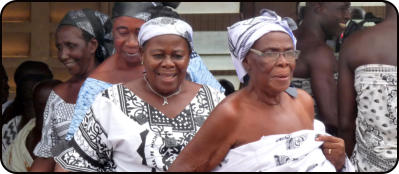


•
Aburi: Botanical Gardens
•
Mampong: Ghana’s first cocoa farm
•
Lake Bosumtwi: Sacred lake of Ashanti gods
•
Ashanti culture in Kumasi, Bonwire and Ejisu
•
Boabeng-Fiema: Sacred Mona and Colobus
monkeys
•
Mole NP: Foot safari to look for elephants
•
Larabanga: Ghana’s oldest mud mosque
•
Five nights at the beautiful Ankobra Beach
Resort
•
Nzulezo stilt village and Ankasa NP
•
Ghana’s most picturesque fishing villages
•
Elmina and Cape Coast: Slave castles
•
Kakum National Park: Exciting canopy walk
•
Mesomagor: Famous Bamboo Orchestra
•
Accra: Between tradition and modern lifestyle
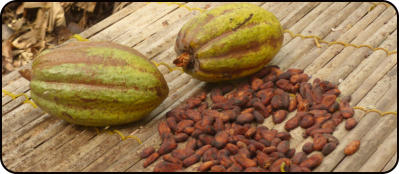








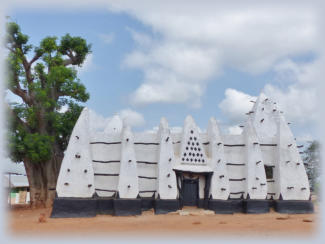
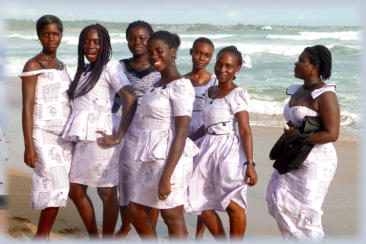
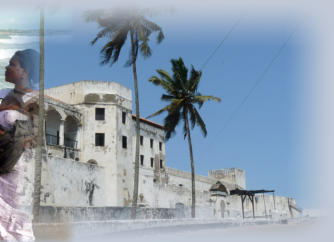
Vero Tours

On this journey through Ghana we discover the most exciting sites of one of West Africa’s friendliest nations. From Ghana’s vibrant
capital, Accra, the trip goes to the flat savannah in the north of the country. We experience colourful markets, exhilarating dances and the
traditional ways of life of various ethnic groups. We also make safaris in Mole National Park in search of wildlife, trek through pristine
rainforest in Kakum and Ankasa and visit impressive historical sites in Elmina, Cape Coast and Kumasi. In the tropical paradise of the
Ankobra Beach Resort we relax, indulged in the delicious cuisine of the coastal region!
Tour Highlights:





















